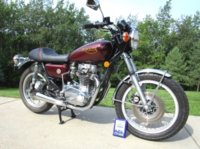My usual comment on this discussion; after end play is set; assemble into frame and check for excessive clearance between frame and assembled swing arm components, if needed add some 3/4" machine bushings to take up any gap, don't just reef the crap out of the pivot bolt to rack the frame, bend the frame bosses out of alignment, put bending forces on the pivot tube and bolt, perhaps causing the threads on the pivot bolt to fail. I've found some that needed extra bushings, some that were fine, 

Last edited:


